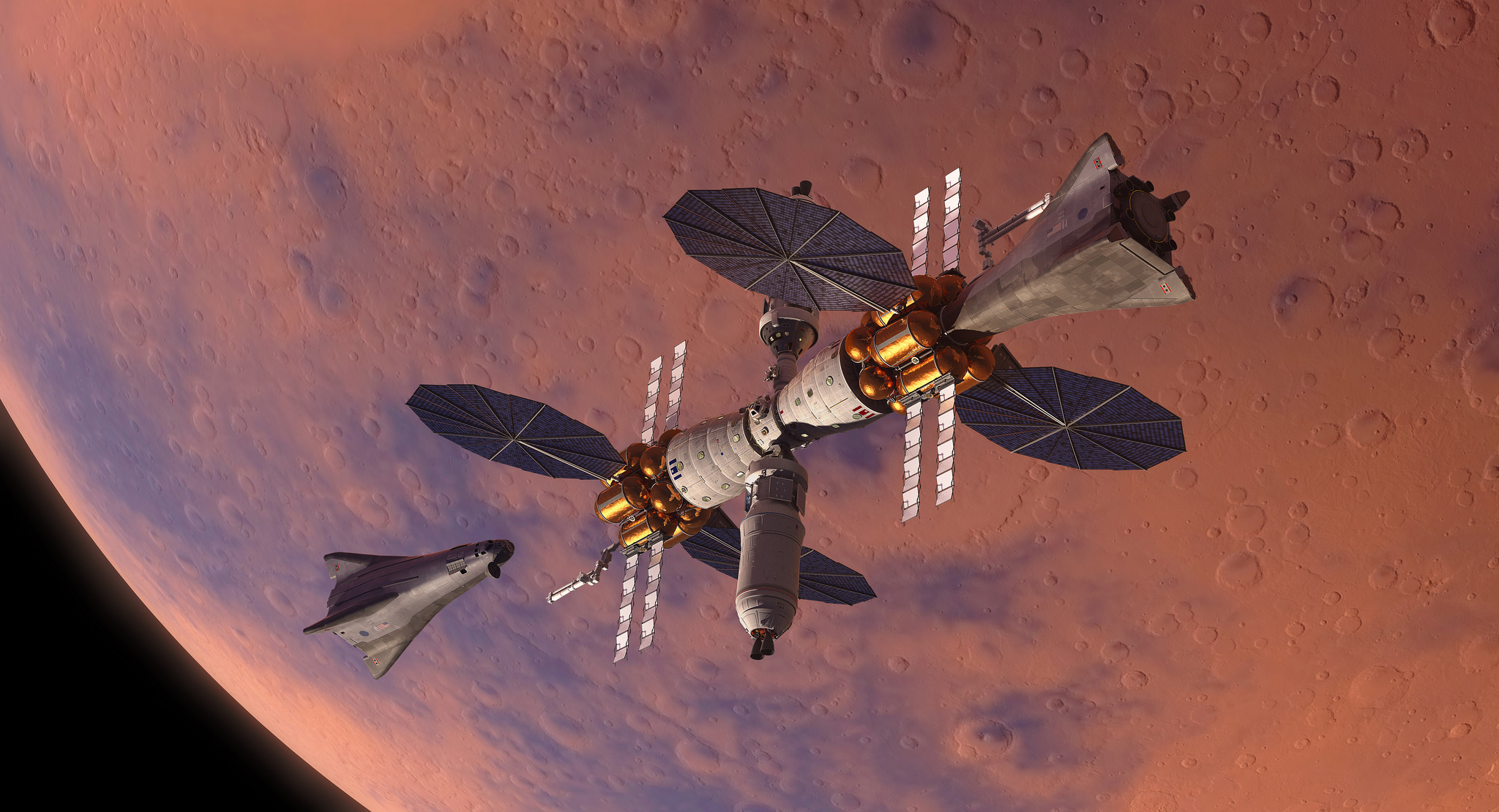Lockheed Martin Unveils Sleek, Reusable Lander for Crewed Mars Missions
A commercial effort to get humans into orbit around Mars in the late 2020s now includes a sleek vehicle to send astronauts down to the surface of the Red Planet.
The aerospace company Lockheed Martin late Thursday (Sept. 28) revealed new details for its Mars Base Camp plan, an architecture aimed at building a crewed space station in orbit around the Red Planet that would support long-term exploration at Mars by astronautson 1,000-day missions. Among the updates unveiled was a tantalizing design for a reusable, single-stage surface lander called the Mars Ascent/Descent Vehicle (MADV). [In Pictures: Lockheed Martin's Mars Base Camp Plan]
The MADV would attach to the space station, and travel to and from the Martian surface via supersonic retropropulsion, which uses rocket engines to slow the lander from supersonic speeds during its descent, according to three Lockheed Martin engineers who discussed the lander in a presentation at the International Astronautical Congress (IAC) in Adelaide, Australia. Supersonic retropropulsion is the same approach used by SpaceX in to land its reusable Falcon 9 rocket boosters.

A base camp for Mars
The initial crewed missions to the Martian surface would be "relatively short-duration, science-focused missions," according to a newly-released report from the company (which you can read and download here). Eventually, the reusable lander would allow up to four astronauts to take two-week missions to the ground. The report suggests sending two landers, mostly for redundancy purposes to ensure astronauts don't get stuck on the surface of the planet.
The lander would refuel on the space station, and would utilize liquid hydrogen fuel, which would come from water molecules broken into their composite oxygen and hydrogen atoms. (This requires energy that would be supplied by the solar panels on the station.)
The use of liquid hydrogen and liquid oxygen as propellant is an integral part of the entire Mars Base Camp (MBC) architecture, the company representatives said. While that water could initially come from Earth, it could later come from water ice frozen on asteroids, in shadowed regions of the moon's surface, from possible sources on Mars' two moons, or from Mars itself. The water would be delivered to the station by a Water Delivery Vehicles (WDVs), which could be operated by a separate commercial entity, the Lockheed Martin engineers said.

The crew quarters on the lander would be designed after NASA's Orion human crew capsule for deep-space exploration, which is still in development, but which NASA plans to use in its pursuit of a human Mars mission. Lockheed Martin is NASA's prime contractor for Orion.
Get the Space.com Newsletter
Breaking space news, the latest updates on rocket launches, skywatching events and more!
Lockheed Martin is developing its Mars habitat design as part of NASA's Next Space Technologies for Exploration Partnerships (NextSTEP) program. The company received $982,039 in funding from the first round of the program.
From the moon to Mars
The MBC also relies on the use of NASA's Deep Space Gateway at the moon, which is likely to be a small orbiting space station. This would serve as a waystation or in-space launching point for crewed missions on the way to Mars.
The MBC architecture would also use of NASA's Space Launch System (SLS) rocket, currently in development, to get astronauts and components to Mars, the company has said. The MBC space station would consist of multiple separate components, some of which would be launched straight from Earth, while others might undergo some construction in cislunar space.
Mars Base Camp is named after the base camps set up for climbing expeditions to the tops of mountains like Everest. In this case, the "peak" is down on the surface, and the base camp is in orbit, and would serve a similar purpose to those mountain camps: a place for humans to prepare before making their way to the surface of the Red Planet.
"Base camps are not a destination unto themselves," said Rob Chambers, one of the Lockheed engineers who spoke at the conference. "They're a place from which you then set out — in this case, to descend to the surfaces of other worlds."
Follow Calla Cofield @callacofield. Follow us @Spacedotcom, Facebook and Google+. Original article on Space.com.
Join our Space Forums to keep talking space on the latest missions, night sky and more! And if you have a news tip, correction or comment, let us know at: community@space.com.

Calla Cofield joined Space.com's crew in October 2014. She enjoys writing about black holes, exploding stars, ripples in space-time, science in comic books, and all the mysteries of the cosmos. Prior to joining Space.com Calla worked as a freelance writer, with her work appearing in APS News, Symmetry magazine, Scientific American, Nature News, Physics World, and others. From 2010 to 2014 she was a producer for The Physics Central Podcast. Previously, Calla worked at the American Museum of Natural History in New York City (hands down the best office building ever) and SLAC National Accelerator Laboratory in California. Calla studied physics at the University of Massachusetts, Amherst and is originally from Sandy, Utah. In 2018, Calla left Space.com to join NASA's Jet Propulsion Laboratory media team where she oversees astronomy, physics, exoplanets and the Cold Atom Lab mission. She has been underground at three of the largest particle accelerators in the world and would really like to know what the heck dark matter is. Contact Calla via: E-Mail – Twitter









